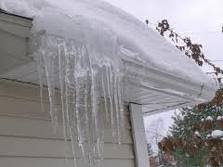Potential Buyer Inspection Issue
[Editor’s Note: Seller liability for ice dams and other home issues is case-specific, and affected by local and state law. For legal advice, please contact an attorney.]
While the Twin Cities is already on its 3rd (5th?) blast of arctic air this season, there’s been precious little snow (in fact, the two phenomena are often inversely related).
 Not so closer to the East Coast, where Erie, Pennsylvania just got socked with over 50″ of snow.
Not so closer to the East Coast, where Erie, Pennsylvania just got socked with over 50″ of snow.
As temps thaw later this Winter, you’d guess at least a few homes there will (re)develop ice dams, and at least a couple of those will be transferring title as well soon (i.e., they’re under legal contract, and scheduled to close within 6-8 weeks max).
Which begs the perennial question, “how do Buyer and Sellers handle ice dams?”
Or, perhaps more to the point, “Who pays for any needed repairs?”
When Did It Happen?
Prior to closing, the answer’s simple: the Seller — either personally or through their insurance; otherwise, through a commensurate reduction in the sales price (subject to lender-approval).
It’s the Seller’s house till it isn’t, and ice dam-related damage is no different than any other property damage, including a wet basement, storm-related roof or siding damage, etc.
In other words, the usual rigmarole with insurance companies, deductibles, contractor bids, etc.
Which leaves scenario #2: an ice dam that arose subsequent to closing.
Scenario #2
At least in Minnesota, there is a two-pronged legal standard for recovery: 1) the problem had to exist before the  Buyer purchased the home; and 2) the Seller had to know ” or should have known ” about the problem.
Buyer purchased the home; and 2) the Seller had to know ” or should have known ” about the problem.
So, a home buyer who closed on a balmy day last Fall . . . flunks test #1, never mind about #2.
But what if the home historically suffered from ice dams, and this year’s are simply the latest recurrence?
Usually, there’s residual evidence that a home previously had ice dams, even after the damage has been repaired.
Plus, a good home inspector will note the roof’s pitch and design, following any roof valleys to the home’s interior ceiling(s) to look for signs of past leaking (stains, fresh paint, etc.).
Seller Disclosure
Of course, Minnesota law also requires that Home Sellers tell prospective Buyers if they’ve previously had ice dams ” or any other roof damage ” in state-mandated disclosure forms.
 Misrepresenting such material information not only risks liability for fraud (and its open-ended statute of limitations), but isn’t likely to fool a Buyer who does their due diligence.
Misrepresenting such material information not only risks liability for fraud (and its open-ended statute of limitations), but isn’t likely to fool a Buyer who does their due diligence.
For all those reasons, it’s likely that either a home hasn’t previously had ice dams ” or, if it did, the issue was identified and dealt with prior to closing.
Bottom line?
Just like Buyers usually can’t recover from Sellers when, post-closing, they get water in their basement after a rare, torrential rain, it’s unlikely that they have recourse for ice dams following record-setting 2018 snowfall . . . somewhere.
Fortunately, most homeowners’ insurance policies cover ice dam-related roof damage, subject to a deductible.
See also, “Seller Liability for Ice Dams“; “Anyone Know a Good Ice Dam Removal Company?“; “Detecting an (Early) Ice Dam in December”; “Ice Dam First Aid“; and “The “N’ is Silent.”

